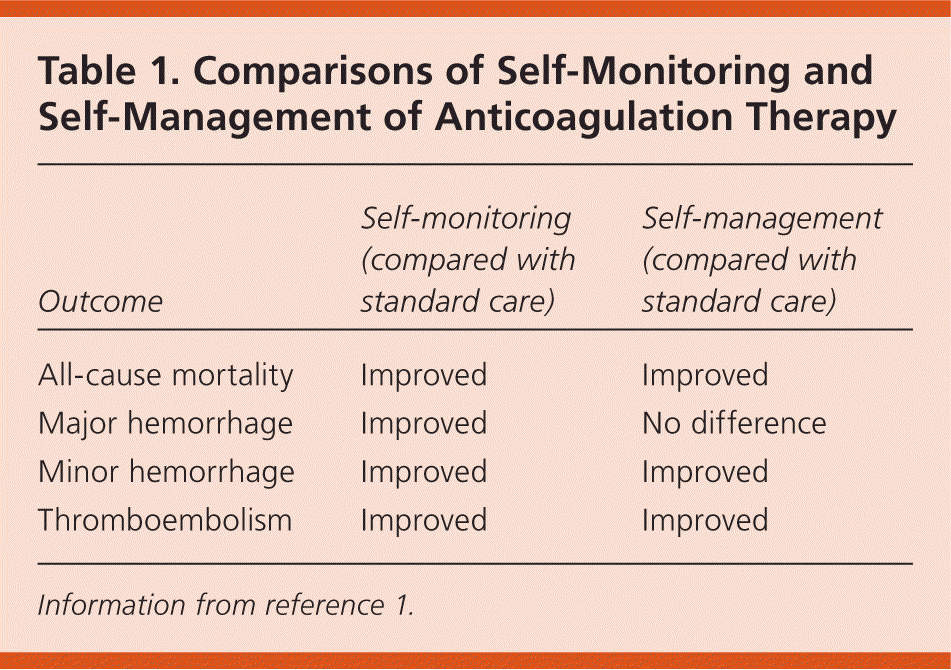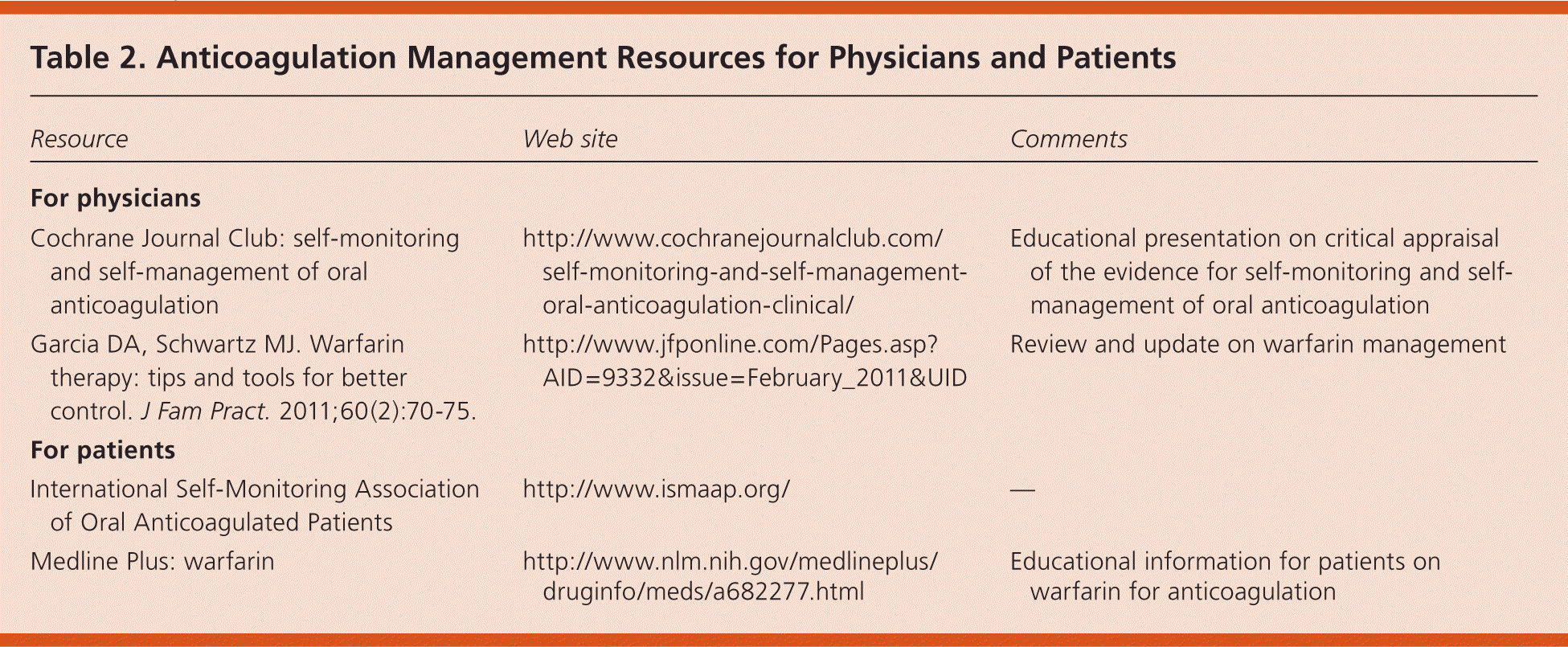
Am Fam Physician. 2011;84(3):266-268
Author disclosure: No relevant financial affiliations to disclose.
Clinical Scenario
A patient with recurrent venous thromboembolism is receiving long-term anticoagulation therapy with warfarin (Coumadin). He is concerned about the inconvenience of regular laboratory visits for anticoagulation monitoring and about the long-term safety of warfarin use.
Clinical Question
Can self-monitoring and self-management improve the safety, effectiveness, and feasibility of long-term oral anticoagulation therapy?
Evidence-Based Answer
Self-monitoring and self-management of long-term oral anticoagulation therapy reduce the risks of thromboembolism, all-cause mortality, and minor hemorrhage for appropriately selected patients.1 (Strength of Recommendation = A, based on consistent, good-quality patient-oriented evidence.)
Cochrane Abstract
Background: The introduction of portable monitors (point-of-care devices) for the management of patients on oral anticoagulation allows self-testing by the patient at home. Patients who self-test can either adjust their medication according to a predetermined dose—International Normalized Ratio (INR) schedule (self-management), or they can call a clinic to be told the appropriate dose adjustment (self-monitoring). Several trials of self-monitoring of oral anticoagulant therapy suggest this may be equal to or better than standard monitoring.
Objectives: To evaluate the effects of self-monitoring or self-management of oral anticoagulant therapy compared with standard monitoring.
Search Strategy: We searched the Cochrane Central Register of Controlled Trials (CENTRAL; The Cochrane Library 2007, Issue 4), Medline, EMBASE, and CINAHL (to November 2007). We checked bibliographies and contacted manufacturers and authors of relevant studies. No language restrictions were applied.
Selection Criteria: Outcomes analyzed were thromboembolic events, mortality, major hemorrhage, minor hemorrhage, tests in therapeutic range, frequency of testing, and feasibility of self-monitoring and self-management.
Data Collection and Analysis: The review authors independently extracted data. We used a fixed-effect model with the Mantel-Haenszel method to calculate the pooled risk ratio (RR) and the Peto method to verify the results for uncommon outcomes. We examined heterogeneity amongst studies with the Chi(2) and I(2) statistics.
Main Results: We identified 18 randomized trials (4,723 participants). Pooled estimates showed significant reductions in thromboembolic events (RR = 0.50; 95% confidence interval [CI], 0.36 to 0.69) and all-cause mortality (RR = 0.64; 95% CI, 0.46 to 0.89). This reduction in mortality remained significant after the removal of low-quality studies (RR = 0.65; 95% CI, 0.46 to 0.90). Trials of self-management alone showed significant reductions in thromboembolic events (RR = 0.47; 95% CI, 0.31 to 0.70) and all-cause mortality (RR = 0.55; 95% CI, 0.36 to 0.84); self-monitoring did not (thrombotic events RR = 0.57; 95% CI, 0.32 to 1.00; mortality RR = 0.84; 95% CI, 0.50 to 1.41). Self-monitoring significantly reduced major hemorrhages (RR = 0.56; 95% CI, 0.35 to 0.91), whereas self-management did not (RR = 1.12; 95% CI, 0.78 to 1.61). Twelve trials reported improvements in the percentage of mean INR measurements in the therapeutic range. No heterogeneity was identified in any of these comparisons.
Authors' Conclusions: Compared with standard monitoring, patients who self-monitor or self-manage can improve the quality of their oral anticoagulation therapy. The number of thromboembolic events and mortality were decreased without increases in harms. However, self-monitoring or self-management was not feasible for up to one-half of the patients requiring anticoagulant therapy. Reasons included patient refusal, exclusion by their general practitioner, and inability to complete training.
These summaries have been derived from Cochrane reviews published in the Cochrane Database of Systematic Reviews in the Cochrane Library. Their content has, as far as possible, been checked with the authors of the original reviews, but the summaries should not be regarded as an official product of the Cochrane Collaboration; minor editing changes have been made to the text (http://www.cochrane.org).
Practice Pointers
The number of patients treated with long-term oral anticoagulation therapy for atrial fibrillation, heart valve replacement, or venous thromboembolism continues to increase. Warfarin is the most commonly used oral anticoagulant, but monitoring anticoagulation intensity with regular International Normalized Ratio (INR) testing is required. An INR less than 2 is associated with an increased risk of thromboembolism, whereas an INR greater than 4.5 is associated with an increased risk of hemorrhage. The amount of time a patient spends within the therapeutic INR target range depends on the frequency of anticoagulation monitoring.2
A 2006 meta-analysis of 14 randomized controlled trials found that self-monitored anticoagulation therapy reduced thromboembolic events, all-cause mortality, and major hemorrhage. However, when patients self-monitored and self-managed anticoagulation therapy, there were reductions in thromboembolic events and death, but not in major hemorrhage.3 This Cochrane review updates the evidence for self-monitoring and self-management of anticoagulation therapy by including trials published since the 2006 meta-analysis.
In this review, thromboembolic events were reduced in patients who self-monitored their anticoagulation therapy (risk ratio [RR] = 0.57), but were further reduced in patients who self-monitored and adjusted their anticoagulation therapy based on self-monitoring (RR = 0.47). Patients who self-monitored and self-managed also had a reduced risk of all-cause mortality (RR = 0.64). Major hemorrhage (e.g., hemorrhage requiring hospital admission or transfusion) was reduced in trials of self-monitoring, but was not reduced in trials of self-management. Minor hemorrhage (e.g., bleeding after minor trauma, nosebleed) was reduced with self-monitoring and with self-management. The percentage of time spent within the therapeutic target range was not measured consistently, but several trials showed that the time was increased in patients using self-monitoring and self-management. Comparisons of outcomes between standard care and self-monitoring and self-management of anticoagulation therapy are listed in Table 1.1

| Outcome | Self-monitoring (compared with standard care) | Self-management (compared with standard care) |
|---|---|---|
| All-cause mortality | Improved | Improved |
| Major hemorrhage | Improved | No difference |
| Minor hemorrhage | Improved | Improved |
| Thromboembolism | Improved | Improved |
Three studies in the review found improved patient satisfaction with self-monitoring and self-management. A trial comparing patients' feelings between the two approaches demonstrated improved satisfaction with self-monitoring compared with self-management. However, an average of 68 percent (range = 31 to 88 percent) of patients considered for participation in these trials did not take part in self-monitoring or self-management. Reasons for not participating included device problems, physical limitations, and problems attending or completing the initial assessment for trial participation.1
A study of a primary care population found that patients who self-managed anticoagulation therapy perceived greater self-efficacy compared with patients receiving routine care, and that self-management was not associated with increased anxiety.4
Point-of-care devices for testing INR have been available since the 1980s. The International Self-Monitoring Association of Oral Anticoagulated Patients estimated that approximately 250,000 patients worldwide monitored or managed their own anticoagulation therapy in 2008.5 Before 2008, Medicare coverage for home INR testing applied only to patients with mechanical heart valves. In 2008, coverage of home INR testing was expanded to include patients with chronic atrial fibrillation or venous thromboembolism. Requirements for Medicare coverage include receiving anticoagulation therapy for at least three months before use of the home INR device, and participating in a face-to-face educational program on anticoagulation management.6
This Cochrane review confirms previous findings that self-monitoring and self-management can reduce the risk of thromboembolism and death in patients taking oral anticoagulants, and provides supportive evidence that these approaches also reduce minor hemorrhage. Evidence also suggests that patients prefer these approaches to standard care. Although not all patients are eligible for these methods, evidence suggests that they can reduce risks and increase benefits in patients who are motivated and willing to be trained. Resources on anticoagulation management for physicians and patients are provided in Table 2.

| Resource | Web site | Comments |
|---|---|---|
| For physicians | ||
| Cochrane Journal Club: self-monitoring and self-management of oral anticoagulation | http://www.cochranejournalclub.com/self-monitoring-and-self-management-oral-anticoagulation-clinical/ | Educational presentation on critical appraisal of the evidence for self-monitoring and self-management of oral anticoagulation |
| Garcia DA, Schwartz MJ. Warfarin therapy: tips and tools for better control. J Fam Pract. 2011;60(2):70–75. | http://www.jfponline.com/Pages.asp?AID=9332&issue=February_2011&UID | Review and update on warfarin management |
| For patients | ||
| International Self-Monitoring Association of Oral Anticoagulated Patients | http://www.ismaap.org/ | — |
| Medline Plus: warfarin | http://www.nlm.nih.gov/medlineplus/druginfo/meds/a682277.html | Educational information for patients on warfarin for anticoagulation |
